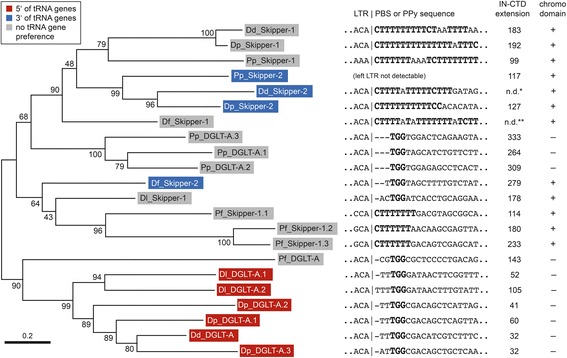Fig. 3.

Phylogeny of dictyostelid LTR retrotransposons. Alignment of the concatenated core domains of RT, RNH, and IN was generated with ClustalX and analyzed using the Maximum Likelihood method. Numbers next to each node indicate bootstrap values as percentages out of 1000 replicates. All positions containing gaps and missing data were eliminated. The tree is drawn to scale with branch lengths measured in the number of substitutions per site. Analysis of the data using the Neighbor Joining method produced a slightly different tree topology (see Additional file 1: Figure S3). Retrotransposons integrating upstream and downstream of tRNA genes are indicated in red and blue boxes, respectively. The sequence immediately downstream of the left LTR in each retrotransposon is shown, with the TGG signature of a canonical primer binding site (PBS) or the polypyrimidine tract (PPy) highlighted in bold. The lengths of the carboxy-terminal extensions of IN domains in individual retrotransposons are indicated and were calculated from the conserved GPY/F motifs to the carboxyl end. It is also indicated whether the IN extensions contain a chromo domain. Dd: D. discoideum; Dp: D. purpureum; Dl: D. lacteum; Df: D. fasciculatum; Pp: P. pallidum; Pf: Protostelium fungivorum; IN-CTD: carboxy-terminal extension of integrase. n.d.: not determined (*: ORF degenerated; **: length of extension undetermined because LTR is missing)
